Try these high protein vegan snacks for recovery
HIgh protein vegan snacks and meals are essential if you are eating plant based and working on recovery from an eating disorder or disordered eating. Snacking well on a plant based diet can make meeting your nutritional needs trickier, especially if you are recovering from an eating disorder. Many recovery foods rely upon animal products such as dairy and eggs to help meet calorie and nutritional requirements.
Because going plant based can be another form of restriction, there can be concerns about this dietary and lifestyle choice during recovery. It can mean you need to eat more volume or focus on a narrower range of foods but this doesn’t mean that you can’t be vegan and recover. It is something to discuss with your treatment team and to think about whether it is the right thing for you. Luckily, there are lots of options for plant based snacks, high calorie meals and vegan meal replacements to support your recovery. It just takes a bit of thought and planning.
High protein vegan snacks for recovery

Snacks are definitely an important part of eating disorder recovery. They can help you to meet energy and nutritional needs that can be higher during recovery. Eating little and often can be convenient and can help if you struggle with larger meals. Planning in high protein vegan snacks can help here.
So how should you plan out your high protein vegan snack? Aim to have snacks based up of two or more food groups to have a satisfying, nourishing snack. For example adding nuts to a portion of fruit or vegan cheese with crackers.
A reminder of those foods groups:
1. Fruit and vegetables.
2. Protein: all nuts, all seeds, hummus, beans and pulses (chickpeas, edamame beans, lentils), sprouted seeds, tofu, tempeh, nut butter, nutritional yeast, pea protein, quinoa.
3 Carbohydrates: potato, bread products, oats, wholegrains, popcorn, pasta, rice.
4. Calcium foods: plant mylks/yoghurt, firm set tofu, fortified ready oats (such as Readybrek), kale, sesame seeds, tahini, tempeh
5. Fats and Sugars.
High protein vegan snack Ideas:
When you are planning your high protein vegan snacks, try to include at least 2 of those foods groups at each snack. This won’t work perfectly everytime, that’s ok too, but it’s a good concept to use when you can.
For example: pair vegetables with protein or fruit with a calcium food.
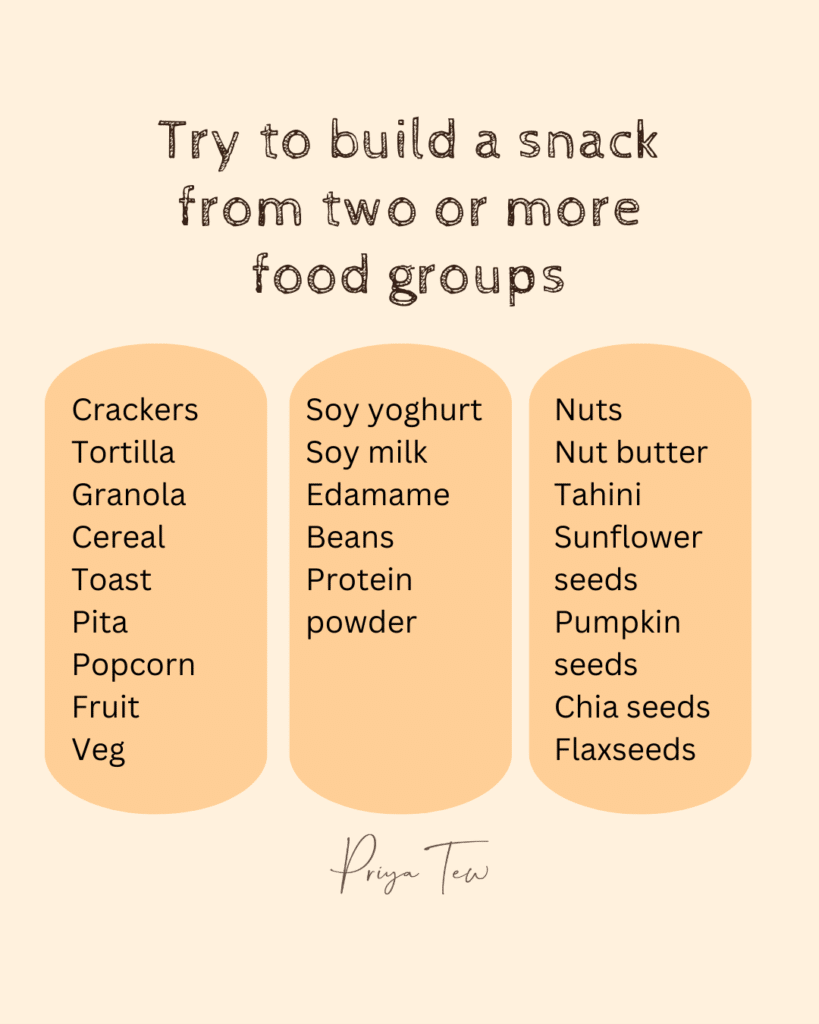
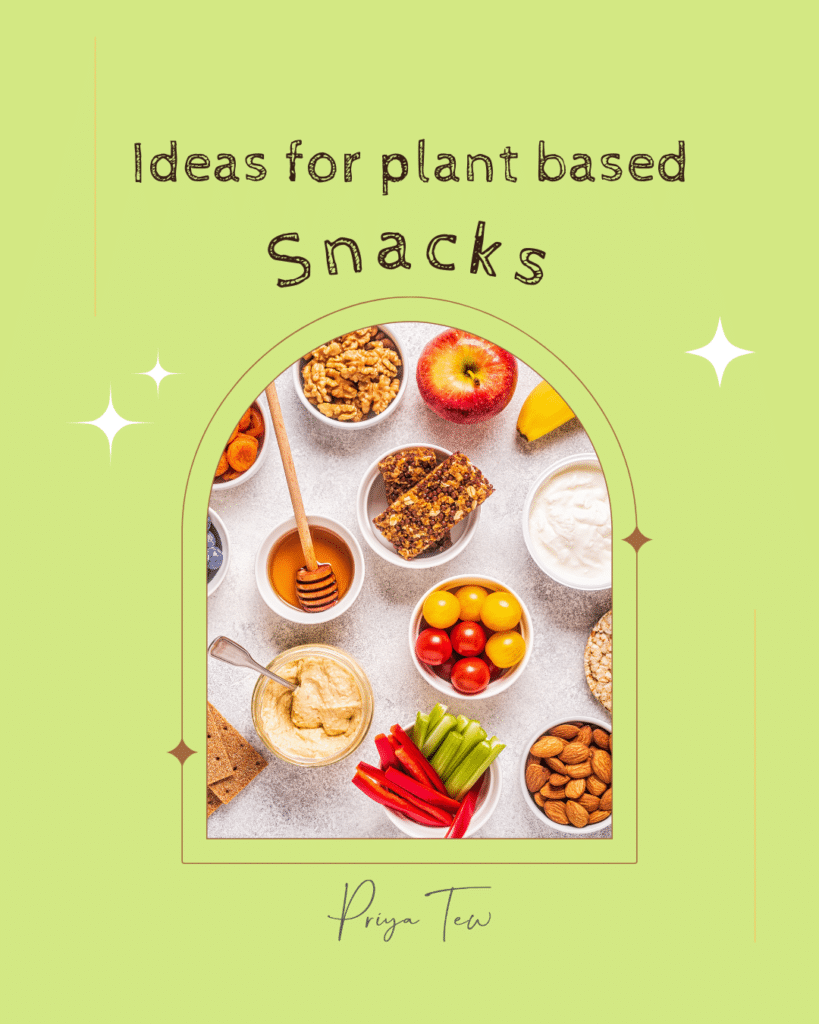
- 3-5 wholegrain/oat crackers with plant based cheese
- 1 tbsp hummus and vegetables with a sprinkle of seeds
- Homemade vegan flapjack
- 2 tbsp granola and 100-150g soy/plant yoghurt
- 1 apple spread with 2 tsp peanut butter
- 30g oatmeal cooked with plant mylk, topped with seeds
- “Ants on a log”. Top strips of celery with peanut butter and raisins on top.
- Roasted chickpeas with plant based cheese
- Toast spread with tahini or nut butter and banana
- 1 ramekin dish or large handful of edamame beans
- 1 large handful of mixed nuts and seeds
- Make your own snack box with fruit, nuts/seeds and something sweet. E.g: Raspberries, dark chocolate and almonds
- Popcorn and a glass of soy mylk
- Make a berry smoothie with protein powder or soy yoghurt
- Gingernut energy balls
- Mushroom pate on crackers
How to increase the nutrition of your vegan meals
Vegan and plant based meals can sometimes be less calorie-dense than those with animal products. Additionally, your energy needs may be higher if you are recovering from an eating disorder, due to hypermetabolism. Because of this, you may need to get strategic about ways to increase the calories in your meal. Try some of the following:
- Adding higher fat products like coconut milk and plant-based creams to meals. This works well for curries, soups, risotto and casseroles.
- Sprinkle nuts and seeds onto dishes. For example stir fries, salads, fajitas and even soups.
- Make sure you have a large enough portion of starchy foods. This food group includes: bread, rice, pasta, couscous and grains, noodles and potatoes.
- Slowly build towards larger portions, if you’re used to small portions. Remember if you have been restricting your intake, your body can actually need extra nutrition to heal inside.
- Although vegetables are important, make sure that you’re not filling up so much on veggies so that you have no room for other foods. They do take up volume in your stomach.
- Have a glass of juice or plant mylk with your meal.
- Add in a dessert each day. This can help you make sure you have some of those fun foods in your day too.
- Have a larger breakfast and lunch -your evening meal doesn’t have to be the only main meal.
HIgh protein Vegan Meal Ideas
Below I have shared some recipe inspiration that I hope will help you find some high protein plant based meals.
High protein vegan lunch ideas:
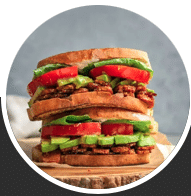
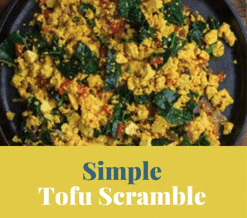
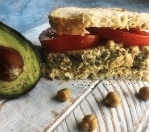
Tempeh BLT sandwich. Make the tempeh in advance for a few days of lunches.
Chickpea Mash – A lovely sandwich filling that is just that bit different from hummus.
Silken Tofu Scramble – a must have recipe for your lunches, so easy to make.
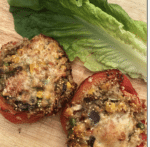
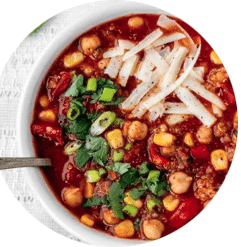
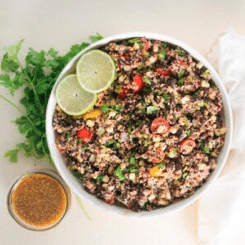
These Stuffed peppers need to be made ahead but they are lovely in a packed lunch and you can make a batch and freeze them.
Here’s a nutritious Mexican bean soup for those colder days. Add a roll on the side.
Quinoa Bowls are super tasty for lunches and you can add your favourite ingredients to make it your own.
High protein vegan dinner ideas:

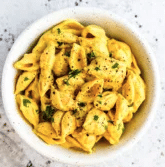
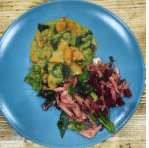
Sometimes varying the type of pasta you are using can help, as in this Lentil pasta with tempeh and spinach
Cashew sauce mac and cheese is not something I’ve tried yet but it looks delicious.
This Aubergine and Sweet potato curry is super delicous and can be served on its own with rice or why not add a homemade naan too.
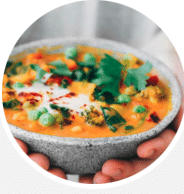
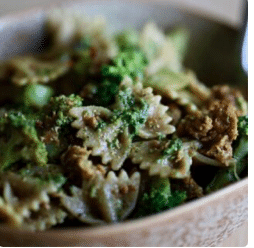
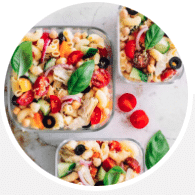
Or try this chickpea based vegan thai Curry for a yummy “fakaway” meal.
Veggie sausage pesto pasta bake is a great family meal to make.
Try this Mediterranean Quinoa salad for a summers option and make extras for lunch the next day!
Vegan meal replacements
Sometimes, a meal replacement can be a really helpful part of your diet. Note, by diet, we mean all the foods and drinks that you consume, not being “on” a diet.
We tend to think about meal replacements as shakes, but they can come in other forms, like bars or soups, too. These can be bought or homemade. Meal replacements should be calorie dense for their size or volume.
The first thing to be aware is that there is a difference between a meal replacement and nutritional supplement. Nutritional supplements are designed to be taken alongside a meal, or as a snack. Double check the packaging to see if the product is designed as a meal replacement or nutritional supplement to ensure that you’re eating enough.
Do be careful with nutritional supplements and meal replacements. These are designed to support your diet, but you ideally want to be eating a varied diet with whole foods. If you are working with a dietitian, they’ll be able to advise how to fit it into your day in a way that supports your recovery.
Used properly, meal replacements and nutritional supplements can:
- Help you to meet your calorie requirements
- Support if you’re struggling to eat large meals
- Provide a wide range of nutrients
- Combat malnutrition
Vegan meal replacement shakes:
These vegan meal replacement shakes are taken from NHS recommendations. They use ingredients like coconut cream, vegan ice cream, dates, syrups and peanut butter to increase the calories for a satisfying, recovery-supporting drink. There is not need ot be worried about including these higher calorie ingredients in your shakes and smoothies. The body really does need them for recovery.




